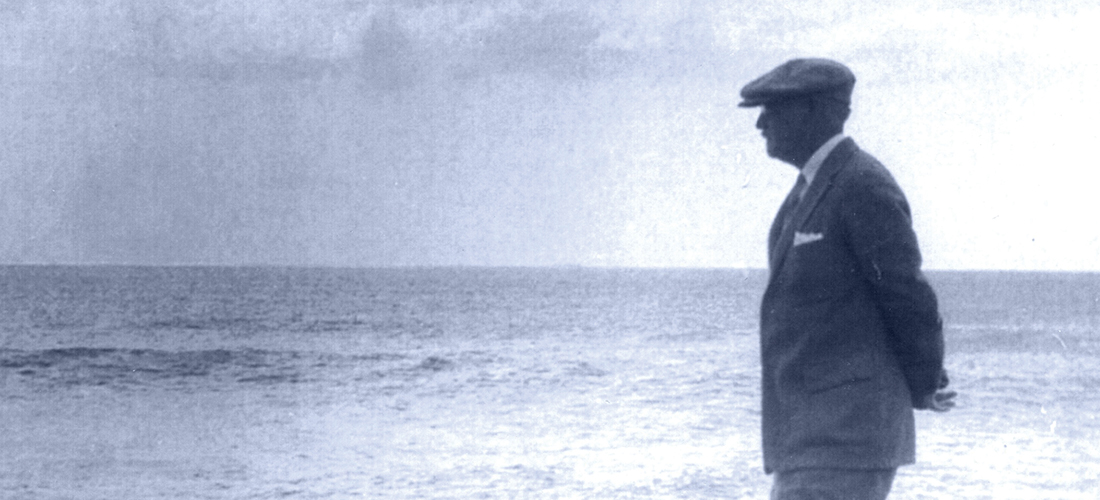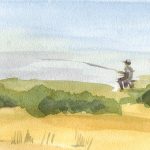
Local author Chris Buie’s engaging new biography of Pinehurst’s Patron Saint of Design
By Lee Pace
Chris Buie moved to Southern Pines as a 10-year-old in the mid-1970s, was a regular golfer and swimmer at what was then known as the Southern Pines Elk Lodge, and later played on O’Neal School teams that won three state golf titles in the early 1980s. All of those PGA Tour stops at Pinehurst No. 2 in the 1970s — with winners from Johnny Miller to Hale Irwin, from Jack Nicklaus to Raymond Floyd — made an indelible mark on an adolescent Buie.
“It was amazing to see your heroes 10 feet away on the tee in a tight match,” he says. “It was absolutely fantastic growing up with that. It was mesmerizing.”
Years later, Buie found himself being similarly affected with the enormity of the 2014 U.S. Open at No. 2. Some 340,000 people flocked to the resort over a fortnight to take in the third Open to be played on No. 2 and the resort’s inaugural Women’s Open that would come the next week. Those events are on top of the two U.S. Amateurs, one Ryder Cup Match and one PGA Championship to have been played on the course that the Scottish architect Donald Ross cobbled from the sand over some three decades from 1907 to 1935.
“I was standing behind the 12th tee on Saturday and took in that panoramic view,” Buie says. “The entire place was packed. I couldn’t believe it. I was just really struck. I guess you could say I had an epiphany. The unusually clear thought is that not one of these people would be there if it was not for this guy Donald Ross.”
At that point Buie, whose career had ranged from social work to marketing and who had authored one book, The Early Days of Pinehurst, decided to delve into the Ross story on his own and produce a book with his findings. The result, The Life & Times of Donald Ross, was released this spring. The 296-page oversized book was published by The Classics of Golf, retails for $75 and is deep with previously unearthed details on Ross’ life and interesting visuals — from shots of a tweed-attired Ross driving a golf ball from the Library of Congress to a map of the 36 holes he built at Oak Hill in Rochester designed with eight “layers,” or starting and stopping points beyond the usual first and 10th tees.
Buie interviewed five people who knew Ross and took advantage of research advances today that allow an author to canvass innumerable newspapers more than a century old from the comfort of his own office and internet connection.
“Being able to tap into that is something that really hasn’t been available before,” Buie says. “Previously, you would have had to travel to a lot of libraries. Anyway, there were a lot of great interviews and information in those old articles.”
Having visited Ross’ hometown of Dornoch, Scotland, twice for chapters in my own books about Pinehurst golf and its evolution, having visited the Dornoch museum and interviewed descendants of Ross’ contemporaries, and certainly having played dozens of Ross courses and written about many of them, I thought my reservoir of Ross knowledge quite extensive. But I found in Buie’s book morsel upon morsel of anecdotes I’d never read or heard before. To wit:
• On the look and feel of Dornoch in 1890, this passage from an English author:
“Although really a seaside place, it is surrounded by woods, moors and mountains, thereby combining such pursuits of the Highlands — as grouse or partridge shooting, deer driving (but not stalking) or fly fishing. Ladies who do not care to follow the gun or play the fly, can find charming spots to sketch, and Dornoch is surrounded by lovely walks and drives, and there are several charming excursions at greater distances.”
• On Sunday golf in Dornoch being considered sacrilegious, that some church-goers were taking odd-looking “walking canes” to worship but actually using them as golf sticks on the way home, sneaking into the dunes for a couple of holes:
“Despite their discretion, most of the villagers knew exactly what the ‘Sabbath breakers’ were up to. As with any small town, little happened without being known by everyone in short order.”
• On Ross’ upbringing in the conservative, strict schools of northern Scotland in the 1870s and an anecdote from his great-grandson, Alex Shapiro:
“He decided to dip the pigtails of a girl that was sitting in front of him in an inkwell on his desk. The teacher came over and hit him so hard that it broke his nose. Donald was so scared about telling his father for fear of what would happen to him that he kept it to himself. So it was never tended to and for the rest of his life he could only breath out of half of his nose.”
• On Ross apparently being at the vanguard of the idea to have front and back nines, an idea at odds to the links concept of the British Isles where most courses ran “out” in one direction along the coast, then turned “in” for the final nine:
“One of the desirable shapes for a piece of golf property is that of a fan,” Ross said. “It gives you the opportunity to place your clubhouse in the center or handle of the fan and lay out two loops of nine holes on either side of the handle … This layout affords another rather pleasant feature, as members can stop after nine holes and have refreshments.”
• On his meeting the titans of American business and being particularly fond of Henry Ford, who asked him to design and build a course for his workers in Dearborn, Michigan:
“(Ford) is a different type of any from almost any other I have met,” Ross said in a 1923 letter to Pinehurst owner Leonard Tufts. “He opened up pretty freely to me, and I have a cordial invitation to stay at his house, and I will accept some time. I would like to know him better. He surely likes peculiar angles, and I already know he has a mind of his own. He would be lost as a President — and it’s entirely outside of his line of endeavor. He is too frank to be a politician. He is a plain democratic man and wealth has not turned his head.”
• On the pressure he felt in the depths of the 1930s Depression to find new projects so that he could keep his workers employed:
“I want to get the contract to build it so that I can find work for a few of my good men here who must be discharged unless I can find other employment,” he said in a 1937 letter to his daughter. “That, you see, is the responsibility that goes with being a father to so many workers. I feel that they depend on me for a livelihood.”
By that time Ross had just completed his final routing of No. 2, adding the current fourth and fifth holes and discarding two that ran into ground now occupied by course No. 4, and had built seven courses in the Sandhills — four at Pinehurst Country Club, one at Pine Needles, one at Mid Pines and 27 holes at Southern Pines. Those were among the some 400 courses he would design across mostly the eastern half of the United States.
Buie says one of the most notable takeaways from his research was how Ross’ fingerprints are on so many elements of golf’s evolution in America — from design to clubmaking to helping elevate the status of the once lowly club pro. The second was how he “instilled the game with the proper spirit,” Buie says. “He was adamant about that. He wanted everything done ‘the right way.’ But he was especially strident about that when it came to golf. He was outspoken about that and vigilant, as well.”
Buie vouched that idea with an interview
he found from a 1939 interview in the Elmira Star Gazette:
“In my long association with golf, covering practically the entire life of the game in the United States, there has never been a scandal in connection with professional golf,” Ross said. “This is a glorious reputation for golf and must be maintained if the game is to continue to hold the respect of the public, and continue in the unusually fine atmosphere it has created.”
One wonders what Ross would have thought of the Tiger Woods story from 2009, but you get the point. PS
Lee Pace has written Golftown Journal since 2008 and has authored four books about golf at Pinehurst, his most recent “The Golden Age of Pinehurst” in 2014.





